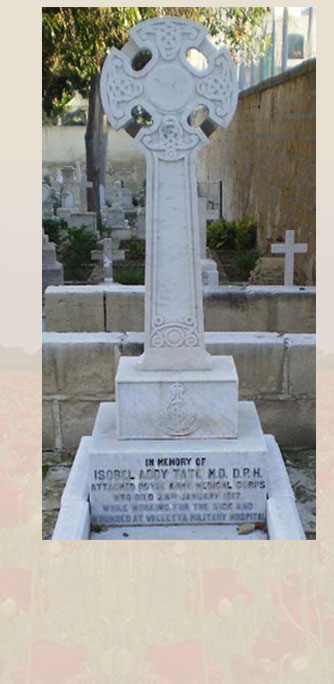

In Memoriam
On the afternoon of Wednesday 10th April, 1918, while the First World War was still ongoing and claiming many lives, a ‘Memorial Service for Nurses who have Fallen in the War’ was held at St Paul’s Cathedral.
Seats were reserved for uniformed nurses and relatives of those who had died. The band of the Coldstream Guards played ‘There is a green hill far away’ while the congregation, including Queen Alexandria and other female members of the royal family, were assembling. The service opened with the hymn ‘O God, our help in ages past’ and the order of service included a roll of honour with 350 names, of which 181 were Voluntary Aid Detachment members. The collection was donated to the Joint War Committee of the Red Cross.
Rolls of honour for WW1 women vary in terms of names and numbers, but over 1,000 women are officially recorded as having died while serving or as a result of service during WW1. Each name tells a unique story.
Born in Ireland, ISOBEL ADDY TATE studied at Queen’s College Belfast, graduating in medicine and surgery in 1899 and working as a medical assistant to a surgeon in East Yorkshire, before qualifying as a doctor of medicine in 1902. She was appointed a resident physician at Hailey sanatorium, Ipsden, near Oxford. She obtained a DPH (diploma in public health) at Manchester in 1904, then took up a post as resident medical officer at Burnley Union Infirmary. Few openings existed for women doctors, other than working with women and children or in public health. The 1911 census shows Isobel aged 34 working as a school medical inspector for Shropshire County Council and boarding at the Boys’ High School, Shrewsbury, an attractive half-timbered property called Old Porch House, now a listed building.
This appeared as her address in the General Medical Register for 1915, the year she volunteered to serve with the Serbian Relief Fund. Accompanied by six other women doctors, she set sail from Liverpool to Salonika with Mabel St Clair Stobart, to serve with Unit 3 of the Serbian Relief Fund at the Stobart Hospital at Kragujevatz. Knowing there had previously been a typhoid epidemic, Stobart had deliberately decided on a tented hospital, in an attempt to avoid infestation by typhoid-carrying lice. Despite the precautions, some hospital staff, including Mrs St Clair Stobart herself, contracted typhoid. Isobel ran the X-ray department and, at one point, a mobile dispensary. Then in 1916 she responded to an appeal from the British Army for women doctors.
In the stone-walled, tree-shaded cemetery at Pieta, Malta, separate from the military section, an imposing marble edifice sits between two army nursing sisters’ more modest graves. Its beautifully carved headstone includes the RAMC badge and the words ‘In memory of Isobel Addy Tate, MD, DPH, attached Royal Army Medical Corps who died 28th January 1917 while working for the sick and wounded at Valletta Military Hospital.’ Her burial on 30th January is recorded in the register of Malta burials (held at The National Archives, document reference WO 156/117). Her death certificate shows her as having died from ‘congestion of the brain’ (due to typhoid fever) at Victoria Junction, Sliema, Malta and gives her unit as ‘Medical Women Garrison Civil Surgeon’. It also gives her date of birth as 1st May 1878. (Her birth appears actually to have been 1st May 1874, in Tartaraghan, Armagh.) Her entry in the ‘Lady Doctors’ Register held at the Army Medical Services Museum archive shows that she embarked for Malta on 24th August 1916, one of 85 women doctors sent there in 1916, among several hundred finally given a chance by the Army to prove their professional worth.
